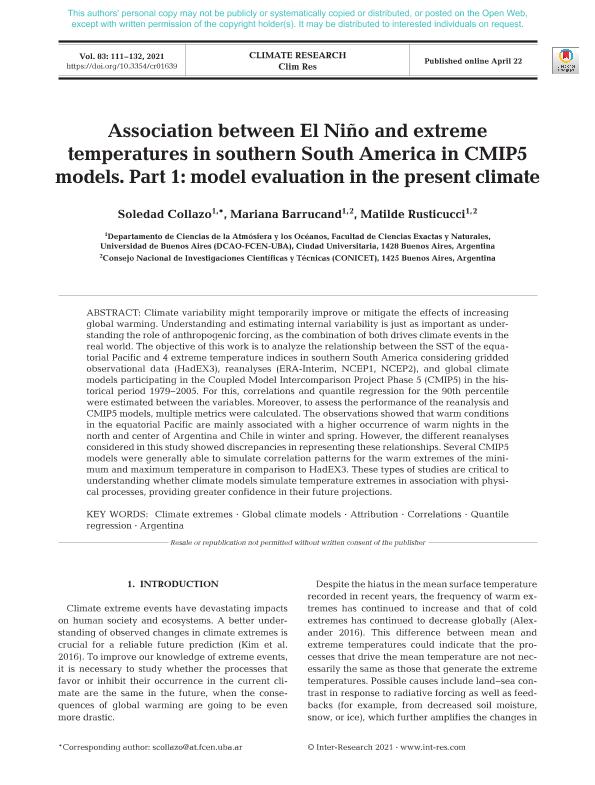Mostrar el registro sencillo del ítem
dc.contributor.author
Collazo, Soledad Maribel

dc.contributor.author
Barrucand, Mariana Graciela

dc.contributor.author
Rusticucci, Matilde Monica

dc.date.available
2022-03-07T12:18:23Z
dc.date.issued
2021-04
dc.identifier.citation
Collazo, Soledad Maribel; Barrucand, Mariana Graciela; Rusticucci, Matilde Monica; Association between El Niño and extreme temperatures in southern South America in CMIP5 models. Part 1: model evaluation in the present climate; Inter-Research; Climate Research; 83; 4-2021; 111-132
dc.identifier.issn
0936-577X
dc.identifier.uri
http://hdl.handle.net/11336/152946
dc.description.abstract
Climate variability might temporarily improve or mitigate the effects of increasingglobal warming. Understanding and estimating internal variability is just as important as understandingthe role of anthropogenic forcing, as the combination of both drives climate events in thereal world. The objective of this work is to analyze the relationship between the SST of the equatorialPacific and 4 extreme temperature indices in southern South America considering griddedobservational data (HadEX3), reanalyses (ERA-Interim, NCEP1, NCEP2), and global climatemodels participating in the Coupled Model Intercomparison Project Phase 5 (CMIP5) in the historicalperiod 1979−2005. For this, correlations and quantile regression for the 90th percentilewere estimated between the variables. Moreover, to assess the performance of the reanalysis andCMIP5 models, multiple metrics were calculated. The observations showed that warm conditionsin the equatorial Pacific are mainly associated with a higher occurrence of warm nights in thenorth and center of Argentina and Chile in winter and spring. However, the different reanalysesconsidered in this study showed discrepancies in representing these relationships. Several CMIP5models were generally able to simulate correlation patterns for the warm extremes of the minimumand maximum temperature in comparison to HadEX3. These types of studies are critical tounderstanding whether climate models simulate temperature extremes in association with physicalprocesses, providing greater confidence in their future projections.
dc.format
application/pdf
dc.language.iso
eng
dc.publisher
Inter-Research

dc.rights
info:eu-repo/semantics/openAccess
dc.rights.uri
https://creativecommons.org/licenses/by-nc-sa/2.5/ar/
dc.subject
CLIMATE EXTREMES
dc.subject
GLOBAL CLIMATE MODELS
dc.subject
ATTRIBUTION
dc.subject
CORRELATIONS
dc.subject.classification
Investigación Climatológica

dc.subject.classification
Ciencias de la Tierra y relacionadas con el Medio Ambiente

dc.subject.classification
CIENCIAS NATURALES Y EXACTAS

dc.title
Association between El Niño and extreme temperatures in southern South America in CMIP5 models. Part 1: model evaluation in the present climate
dc.type
info:eu-repo/semantics/article
dc.type
info:ar-repo/semantics/artículo
dc.type
info:eu-repo/semantics/publishedVersion
dc.date.updated
2022-01-25T15:02:02Z
dc.journal.volume
83
dc.journal.pagination
111-132
dc.journal.pais
Alemania

dc.description.fil
Fil: Collazo, Soledad Maribel. Universidad de Buenos Aires. Facultad de Ciencias Exactas y Naturales. Departamento de Ciencias de la Atmósfera y los Océanos; Argentina. Consejo Nacional de Investigaciones Científicas y Técnicas; Argentina
dc.description.fil
Fil: Barrucand, Mariana Graciela. Consejo Nacional de Investigaciones Científicas y Técnicas; Argentina. Universidad de Buenos Aires. Facultad de Ciencias Exactas y Naturales. Departamento de Ciencias de la Atmósfera y los Océanos; Argentina
dc.description.fil
Fil: Rusticucci, Matilde Monica. Universidad de Buenos Aires. Facultad de Ciencias Exactas y Naturales. Departamento de Ciencias de la Atmósfera y los Océanos; Argentina. Consejo Nacional de Investigaciones Científicas y Técnicas; Argentina
dc.journal.title
Climate Research

dc.relation.alternativeid
info:eu-repo/semantics/altIdentifier/url/https://www.int-res.com/abstracts/cr/v83/p111-132/
dc.relation.alternativeid
info:eu-repo/semantics/altIdentifier/doi/http://dx.doi.org/10.3354/cr01639
Archivos asociados
